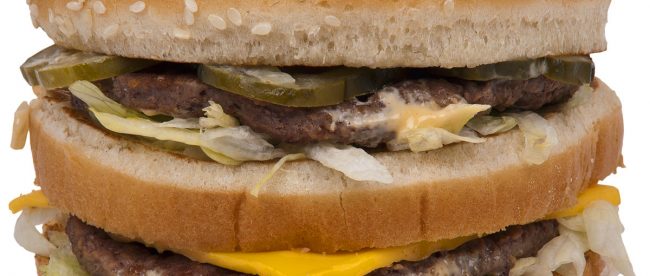How To Fool the World Starting with Two All-Beef Patties

International travel can be a bit tricky, at least when it comes to buying things. First, you often have to deal with a new currency, and different currencies are worth different amounts. Second, prices in Country A are different than that in Country B. Or, a least, they appear to be. In theory, if you try and buy some stuff in County A, it should cost the same as it would in Country B, once you account for the currency exchange rate.
That’s the idea at least — but it’s rarely true. But the deviation from the theory is something worth measuring. Economists do so using a metric is called “Purchasing Power Parity” (“PPP”), which compares the price of a broad group of goods in one country, after accounting for the different currency exchange rates, to the same group of goods in another. It’s complicated and it takes a lot of work, though. So in 1986, The Economist magazine decided to simplify it for their purposes.
Their realization? Almost all countries have at least one McDonald’s. And if you’re at a McDonald’s, no matter what country you’re in or currency you’re using, you can buy yourself a Big Mac. The magazine wondered: could it use the burger as a basis for measuring the PPP of each nation? Sure, there’d be flaws — as Investopedia notes, “the Big Mac differs across the world in size, ingredients, and availability.” But it’d be easy — and fun. (Well, “fun” by the standards of economists, at least.)
Each year since then, The Economist tries to figure the average price of a Big Mac in each of a few dozen countries. Then, it uses exchange rates to figure out what the Big Mac should cost based on that metric. From that, the magazine estimates whether the currency measured (using the US Dollar as a baseline) is overvalued or undervalued. Here’s a screenshot of how the “Big Mac Index,” as The Economist calls it, via their website. Basically: if the exchange rate is 0.72 British pounds per U.S. dollar, a $5.28 Big Mac should cost £3.80. But because it costs only £3.19, you’re getting extra value from your British Extra Value Meal.

In doing the above, though, The Economist unintentionally developed another metric — hamburger-based inflation. The magazine has been tracking Big Mac prices around the world for decades and can see if the price of burgers jumps more than expected. And that’s where the trouble began. A country with out of control inflation will, at times, try to hide that fact by manipulating its currency. And that means those nations may try to cook the Big Mac Index. And that’s what the magazine feared when the numbers in Argentina didn’t seem to match up right.
In January of 2011, the magazine’s editors effectively accused the Argentine government of manipulating Big Mac prices in order to manipulate the Big Mac Index. The magazine noted that “investment analysts suspect that governments are fiddling the figures for political reasons, and that the true inflation rate is much higher than officially reported” and that “the gap between [Argentina’s] average annual rate of burger inflation (19%) and its official rate (10%) is far bigger than in any other country.” The issue warranted further investigation, or as the magazine cheekily stated, “the government deserves a good grilling.”
In 2011 and 2012, visitors to Argentina started noticing something weird about the menus of the local McDonald’s — anecdotes that would suggest that The Economist was right. Big Macs were often priced significantly more cheaply than Quarter Pounders with Cheese, despite the fact that the two products are usually roughly the same price as each other elsewhere. One traveler noted that, in the Mickey D’s he visited, Big Macs were selling for 28 pesos (about $3.28) while Triple Macs — basically a Big Mac with an extra patty and more bun — sold for nearly double that, at 55 pesos. And to make things even weirder, the very cheap Big Mac was buried at the bottom of the menu, as seen here.
Even the New York Times took up the case. Its reporter also canvassed multiple McDonald’s locations throughout the country and found the same thing as above — really cheap Big Macs which were barely advertised as available. In one case, per the Times, “the brightly lit menu behind the cash register” omitted the Big Mac altogether; only “down the hall toward the bathroom” could one find a price list with the Big Mac included. Both the Argentinian government and McDonald’s denied that any price manipulation was going on, but that seemed to be an easily-cast lie. Most likely, as Slate explained, “the Argentine state leaned on Argentina’s McDonaldses to exercise restraint in their Big Mac pricing. That, in turn, has led the McDonaldses to radically de-emphasize the suddenly non-profitable signature sandwich in favor of the Triple Mac and other offerings.”
And Argentina got away with it, too. There’s no penalty for manipulating the price of fast food burgers — this isn’t something the Hague cares about. Neither did the voters. The Argentinian government behind this likely manipulation, by and large, was re-elected in both 2011 and 2013.
Bonus fact: What’s in a Big Mac’s “special sauce”? Well, it’s a special sauce, not a secret sauce. At least that’s the official word from McDonald’s Canada, per executive chef Dan Coudreaut in this video. It’s a mix of mayo, yellow mustard, sweet pickle relish, onion powder, garlic powder, paprika, and white wine vinegar. (In the video, Coudreaut makes a home version of a Big Mac, if you want to watch.)
From the Archives: Kosher Cheeseburgers: Coincidentally, as of 2011, Argentia is one of the few places with a kosher McDonald’s. You can’t get a Quarter Pounder with Cheese there, though.
